#dust ionizer
Explore tagged Tumblr posts
Photo
Lagoon Cocoon by geckzilla on Flickr. (Judy Schmidt)

632K notes
·
View notes
Text
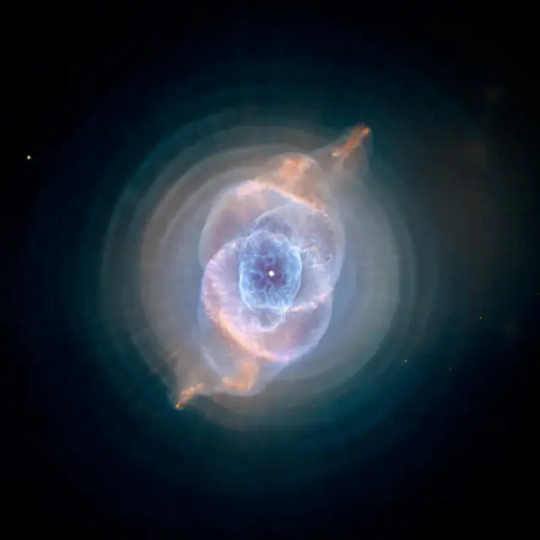
Cat’s Eye Nebula
The Cat's Eye Nebula, also known as NGC 6543, is one of the most well-known planetary nebulae located in the constellation Draco.
It is approximately 3,000 light-years away from Earth and is notable for its intricate structure and vibrant colors.
The Cat's Eye Nebula is formed from the outer layers of a dying star that has shed its material during the late stages of its evolution.
The central star, which is a hot white dwarf, is responsible for the intense ultraviolet radiation that ionizes the surrounding gas, causing it to glow.
One of the most striking features of the Cat's Eye Nebula is its "eyes," which are formed by the concentric shells of gas and dust that create a visually captivating appearance.
Credits: NASA, ESA, HEIC, and the Hubble Heritage Team (STScI/AURA) Acknowledgment: R. Corradi (Isaac Newton Group of Telescopes, Spain) and Z. Tsvetanov (NASA)
411 notes
·
View notes
Text
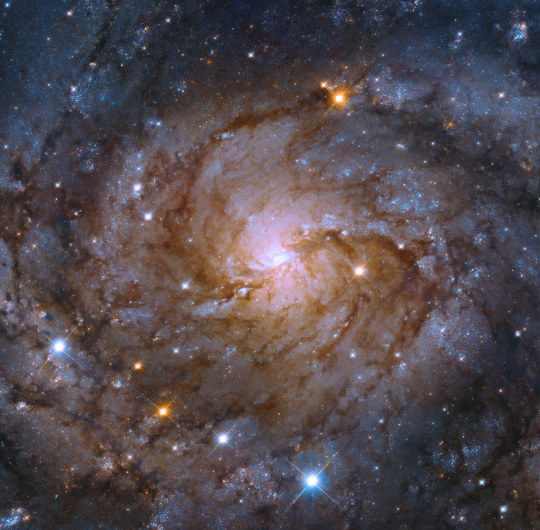
A Hidden Galaxy by NASA Hubble Space Telescope
Spiral galaxy IC 342, also known as Caldwell 5, is located approximately 11 million light-years from Earth. This sparkling, face-on view of the center of the galaxy displays intertwined tendrils of dust in spectacular arms that wrap around a brilliant core of hot gas and stars. This core is a specific type of region called an H II nucleus — an area of atomic hydrogen that has become ionized. Such regions are energetic birthplaces of stars where thousands of stars can form over a couple million years. Each young, extremely hot, blue star emits ultraviolet light, further ionizing the surrounding hydrogen.
174 notes
·
View notes
Photo

2024 December 13
M51: Tidal Streams and H-alpha Cliffs Image Credit & Copyright: The Deep Sky Collective - Tim Schaeffer, Carl Björk, Steeve Body, Fabian Neyer, Aki Jain, Ryan Wierckx, Paul Kent, Brian Valente, Antoine & Dalia Grelin, Nicolas Puig, Stephen Guberski, Mike Hamende, Julian Shapiro, John Dziuba, Mikhail Vasilev, Bogdan Borz, Adrien Keijzer
Explanation: An intriguing pair of interacting galaxies, M51 is the 51st entry in Charles Messier's famous catalog. Perhaps the original spiral nebula, the large galaxy with whirlpool-like spiral structure seen nearly face-on is also cataloged as NGC 5194. Its spiral arms and dust lanes sweep in front of its smaller companion galaxy, NGC 5195. Some 31 million light-years distant, within the boundaries of the well-trained constellation Canes Venatici, M51 looks faint and fuzzy to the eye in direct telescopic views. But this remarkably deep image shows off stunning details of the galaxy pair's striking colors and fainter tidal streams. The image includes extensive narrowband data to highlight a vast reddish cloud of ionized hydrogen gas recently discovered in the M51 system and known to some as the H-alpha cliffs. Foreground dust clouds in the Milky Way and distant background galaxies are captured in the wide-field view. A continuing collaboration of astro-imagers using telescopes on planet Earth assembled over 3 weeks of exposure time to create this evolving portrait of M51.
∞ Source: apod.nasa.gov/apod/ap241213.html
119 notes
·
View notes
Text

Caldwell 33//NGC 6992//Eastern Veil Nubula. Photo taken and processed by me.
A cloud of heated and ionized dust located 2,400ly from earth. Part of the Cygnus Loop, this is the remnant of a star 20 times more massive than our sun that went supernova 10,000–20,000 years ago. At the time, the resulting explosion would have appeared brighter than Venus in the night sky and would have been visible during the daytime.
114 notes
·
View notes
Text

This one took a few nights to capture enough data.
FYI: Bortle skies: 7-8 with a waxing gibbous Moon. Post-processing using Sequator to stack images, ON1 to edit details.
IC 1396, Elephant's Trunk Nebula, is a large, faint emission nebula in the constellation Cepheus. It is a region of glowing ionized gas and dust where new stars are forming. The nebula is energized by a central, bluish multiple star system called HD 206267. This star system's radiation causes the surrounding gas to glow.
41 notes
·
View notes
Text
Alnitak's Treasures

Alnitak, the lower left star in the belt of Orion the Hunter, is surrounded by several prominent nebulas that are part of the Orion Molecular Cloud Complex, a massive star-forming region approximately 1,350 light-years from Earth. These nebulas include:
Located near Alnitak, the Flame Nebula (NGC 2024) is a bright emission nebula. The ultraviolet radiation from Alnitak ionizes hydrogen gas, causing it to emit light. Dark dust lanes cross its bright central region, creating a fiery appearance.
IC 434 is the bright emission nebula that serves as the backdrop for the Horsehead Nebula. Its reddish glow is due to hydrogen gas being excited by the radiation from nearby stars, including Alnitak.
Situated to the right (in this image) Alnitak, the Horsehead Nebula (Barnard 33) is a dark nebula. It is a cloud of dust and gas that appears silhouetted against the bright emission nebula IC 434 that lies behind it.
Located near the Horsehead Nebula, is the bright reflection nebula NGC 2023. It is illuminated by the star HD 37903 and is one of the brightest reflection nebulas in the sky. It features a combination of molecular clouds and photodissociation regions.
These nebulas are intricately linked, forming part of the dynamic and visually stunning Orion Molecular Cloud Complex.
©DoubleStar Photography
38 notes
·
View notes
Text

IC 5146 - the Cocoon Nebula (HaRGB)
An especially fun target to shoot, because it's a combination emission and reflection nebula. The red in its center is ionized hydrogen, which emits a deep red glow, but the areas around the nebula with fewer stars are filled with dust, which reflects nearby starlight to produce the pale blue glow at the nebula's apparent edges.
Shot at 1600mm with a 200mm RC telescope and a ZWO ASI533MM Pro. 2h of Ha integrated exposure time, plus 1h each of RGB data.
All images on my blog, unless noted, are shot from my backyard in Bortle 7 skies.
#astrophotography#astronomy#space#deep sky#nebula#narrowband#night sky#lensblr#galaxy#emission nebula#reflection nebula#cocoon nebula#ic 5146
57 notes
·
View notes
Text
A FrEGGs-plosion of Star Formation !

This Hubble Space Telescope image depicts a special class of star-forming nursery known as Free-floating Evaporating Gaseous Globules, or frEGGs for short. This object is formally known as J025157.5+600606.
When a massive new star starts to shine while still within the cool molecular cloud from which it formed, its energetic radiation can ionize the cloud’s hydrogen and create a large, hot bubble of ionized gas. Located within this bubble of hot gas around a nearby massive star are the frEGGs: dark compact globules of dust and gas, some of which are giving birth to low-mass stars. The boundary between the cool, dusty frEGG and the hot gas bubble is seen as the glowing purple/blue edges in this image.
Credit: ESA/Hubble & NASA, R. Sahai
#space#nasa#universe#art#astronomy#science#galaxy#moon#stars#cosmos#spacex#scifi#astrophotography#photography#earth#astronaut#love#alien#nature#mars#spaceart#sky#spaceexploration#planets#aliens#spaceship#spacetravel#rocket#digitalart#design
33 notes
·
View notes
Text

"THIS STUNNING, DEEP VIEW OF THE LAGOON IS NEARLY 100 LIGHT-YEARS ACROSS."
PIC INFO: Resolution at 1401x2048 -- Spotlight on the The Wide and Deep Lagoon. 📸/🔭: Image & Copyright: Michael Miller, Jimmy Walker.
EXPLANATION/OVERVIEW: "Ridges of glowing interstellar gas and dark dust clouds inhabit the turbulent, cosmic depths of the Lagoon Nebula. Also known as M8, the bright star forming region is about 5,000 light-years distant. But it still makes for a popular stop on telescopic tours of the constellation Sagittarius, toward the centre of our Milky Way Galaxy. Dominated by the telltale red emission of ionized hydrogen atoms recombining with stripped electrons, this stunning, deep view of the Lagoon is nearly 100 light-years across. Right of centre, the bright, compact, hourglass shape is gas ionized and sculpted by energetic radiation and extreme stellar winds from a massive young star. In fact, the many bright stars of open cluster NGC 6530 drift within the nebula, just formed in the Lagoon several million years ago."
-- ASTRONOMY PICTURE OF THE DAY (APOD), published on September 9, 2016
Source: www.star.ucl.ac.uk/~apod/apod/ap160909.html.
#The Wide and Deep Lagoon#Astronomy#APOD#Wide and Deep Lagoon#Space#Outer Space#Deep Space#Space is Deep#Astrophotography#Constellation Sagittarius#Milky Way Galaxy#Colorful#M8#M8 Bright Star Forming Region#Solar System#Bright Star Forming Region#Open Cluster#Astronomy Picture of the Day#Open Cluster NGC 6350#Massive Young Star#Stars#NGC 6350#Lagoon Nebula#Nebulae#Nebula#NASA
22 notes
·
View notes
Text
The sun warms the Earth, making it habitable for people and animals. But that's not all it does, and it affects a much larger area of space. The heliosphere, the area of space influenced by the sun, is over a hundred times larger than the distance from the sun to the Earth. The sun is a star that constantly emits a steady stream of plasma—highly energized ionized gas—called the solar wind. In addition to the constant solar wind, the sun also occasionally releases eruptions of plasma called coronal mass ejections, which can contribute to the aurora, and bursts of light and energy, called flares. The plasma coming off the sun expands through space, along with the sun's magnetic field. Together they form the heliosphere within the surrounding local interstellar medium—the plasma, neutral particles and dust that fill the space between stars and their respective astrospheres. Heliophysicists like me want to understand the heliosphere and how it interacts with the interstellar medium.
Continue Reading.
#Science#Space#Astronomy#Astrophysics#Sun#Heliosphere#National Aeronautics and Space Administration#NASA
71 notes
·
View notes
Text

Veil Nebula
The Veil Nebula is a stunning supernova remnant located in the constellation Cygnus, often referred to as the "Wings of the Swan" .
It is approximately 1,500 light-years away from Earth and spans about 110 light-years across.
The nebula is composed of ionized gas and dust, and it is known for its intricate and delicate filaments, which are the remnants of a massive star that exploded around 8,000 years ago.
The Veil Nebula is divided into several parts, with the most prominent sections being the Eastern Veil (NGC 6992) and the Western Veil (NGC 6960).
Credits: NASA, ESA, and the Hubble Heritage Team (STScI/AURA)
#nebula#space#supernova#galaxy#nasa#constellations#astrophotography#astronomy#cosmos#universe#space exploration#outer space#aesthetic
393 notes
·
View notes
Text

Orion Nebula
"The dusty side of the Sword of Orion is illuminated in this striking infrared image from the European Space Agency's Hershel Space Observatory. This immense nebula is the closest large region of star formation, situated about 1,500 light years away in the constellation of Orion. The parts that are easily observed in visible light, known alternatively as the Orion Nebula or Messier 42, correspond to the light blue regions. This is the glow from the warmest dust, illuminated by clusters of hot stars that have only recently been born in this chaotic region.
The red spine of material running from corner to corner reveals colder, denser filaments of dust and gas that are scattered throughout the Orion nebula. In visible light this would be a dark, opaque feature, hiding the reservoir of material from which stars have recently formed and will continue to form in the future.
Herschel data from the PACS instrument observations, at wavelengths of 100 and 160 microns, is displayed in blue and green, respectively, while SPIRE 250-micron data is shown in red.
Within the inset image, the emission from ionized carbon atoms (C+), overlaid in yellow, was isolated and mapped out from spectrographic data obtained by the HIFI instrument."
Image and information from NASA.
218 notes
·
View notes
Photo
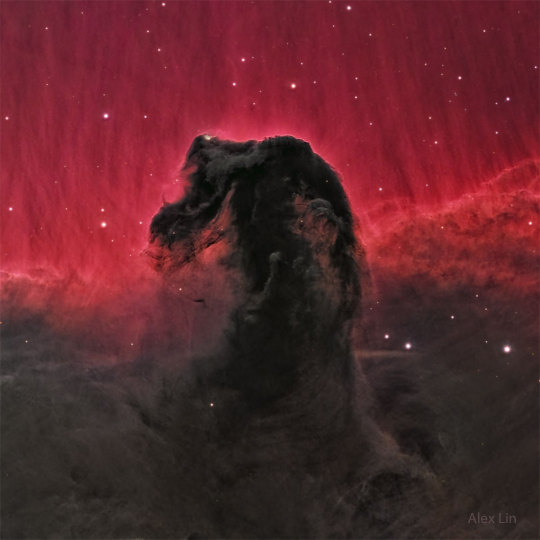
2024 November 25
The Horsehead Nebula Image Credit & Copyright: Alex Lin (Chilescope)
Explanation: One of the most identifiable nebulas in the sky, the Horsehead Nebula in Orion, is part of a large, dark, molecular cloud. Also known as Barnard 33, the unusual shape was first discovered on a photographic plate in the late 1800s. The red glow originates from hydrogen gas predominantly behind the nebula, ionized by the nearby bright star Sigma Orionis. The darkness of the Horsehead is caused mostly by thick dust, although the lower part of the Horsehead's neck casts a shadow to the left. Streams of gas leaving the nebula are funneled by a strong magnetic field. Bright spots in the Horsehead Nebula's base are young stars just in the process of forming. Light takes about 1,500 years to reach us from the Horsehead Nebula. The featured image was taken from the Chilescope Observatory in the mountains of Chile.
∞ Source: apod.nasa.gov/apod/ap241125.html
146 notes
·
View notes
Text
The Year’s Most Spectacular Photos from the James Webb Telescope
By Jeffrey Kluger
December 22, 2023

Close to 1,500 light years from Earth lie a pair of baby stellar twins known as Herbig-Haro 46/47 — which are barely a few thousand years old.
A star the size of our sun, by contrast, takes an average of 50 million years to reach even the stellar equivalent of young adulthood It's Herbig-Haro 46/47's extreme youth that gives the formation more of a blob-like appearance than the stellar duo it is.
Young stars are buried in clouds of dust and gas, which they absorb as they grow. Sometimes, however the infant stars ingest too much material too fast.
When that happens, dust and gas erupts from both sides of the formation, giving the young pair their misshapen look.
But if you have patience — 50 million years worth of patience — what is a blob today will be stars tomorrow.
NASA, ESA, CSA. Image Processing: Joseph DePasquale (STScI)
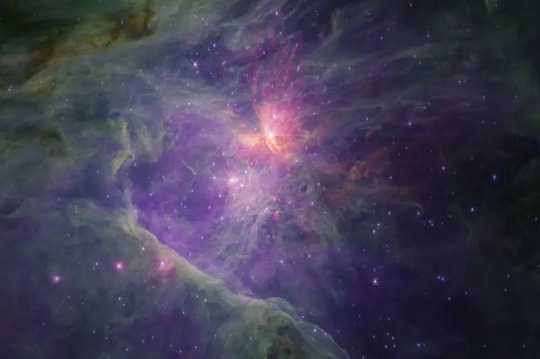
A pair of brilliant stellar nurseries located 1,600 light years from Earth, the Orion Nebula and Trapezium Cluster are home to a relative handful of very young but very bright stars.
Four of the stars are easy to see with a simple, amateur, four-inch telescope.
One of the four — the beast of the young litter — is especially visible, a full 20,000 times brighter than our sun.
Apart from their four main stars, the Orion Nebula and Trapezium cluster contain approximately 700 additional young stars at various stages of gestation.
NASA, ESA, CSA/Science leads and image processing: M. McCaughrean, S. Pearson, CC BY-SA 3.0 IGO

(L): It’s not easy being a Wolf-Rayet star, like this specimen imaged by the Webb telescope at a distance of 15,000 light years.
A rare species of stellar beast — NASA estimates there are only 220 of them in a Milky Way galaxy with at least 100 billion stars — the Wolf-Rayet burns hot and burns fast, with temperatures 20 to 40 times the surface of the sun.
All of that rapidly expended energy causes the star to lose its hydrogen envelope quickly and expose its helium core.
The result: a very early and very violent death.
A star like our sun burns for about 10 billion years. As for a Wolf-Rayet? Just a few hundred thousand before it dissolves into cosmic dust.
NASA, ESA, CSA, STScI, Webb ERO Production Team
(R): If the Wolf-Rayet star dies an ugly and violent death, the celebrated Ring Nebula, photographed by the Webb at a distance of 2,000 light years from Earth, has been expiring beautifully.
The glowing remains of a sun-like star, the nebula was discovered in 1779 by the French astronomer Antoine Darquier de Pellepoix.
As the nebula throws off its outer layers of ionized gas, it reveals its characteristic blue interior, composed of hydrogen and oxygen that have not yet been expelled off by the nebula’s stellar wind.
ESA/Webb, NASA, CSA, M. Barlow (University College London), N. Cox (ACRI-ST), R. Wesson (Cardiff University)
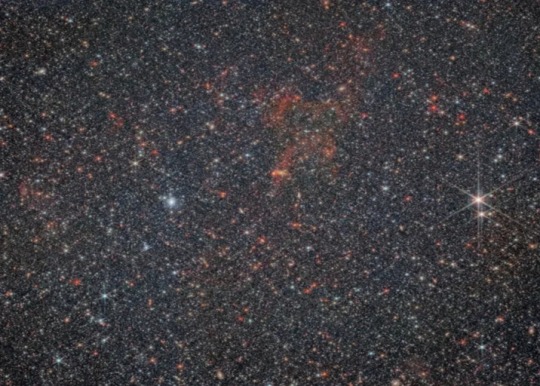
Dwarf galaxy NGC 6822 lives up to to its name — home to just 10 million stars, compared to the minimum of 100 billion in the Milky Way.
But what NGC 6822 lacks in numbers, it makes up in spectacle — which the keen eye of the Webb telescope has revealed.
Discovered in 1884 by American astronomer E.E Barnard, NGC 6822, is now known to have a prodigious dust tail measuring 200 light years across..
What's more, it's home to a dense flock of stars that glow 100,000 times brighter than our sun.
ESA/Webb, NASA & CSA, M. Meixnev

Spiral galaxies are often defined by uneven — and even ragged — arms.
But not galaxy M51, which lies 27 million light years from Earth and is defined by the tautness of its arms and the compactness of its structure.
M51 isn't alone in space. Nearby lies the companion galaxy NGC 5195.
The two galaxies are engaged in something of a gravitational tug of war — one that the NGC 5195 is winning.
NGC's constant gravitational pull is thought to account for both the tightly woven structure of M51's arms and for tidal forces that are thought lead to the creation of new stars in the arms.
ESA/Webb, NASA & CSA, A. Adamo (Stockholm University) and the FEAST JWST team
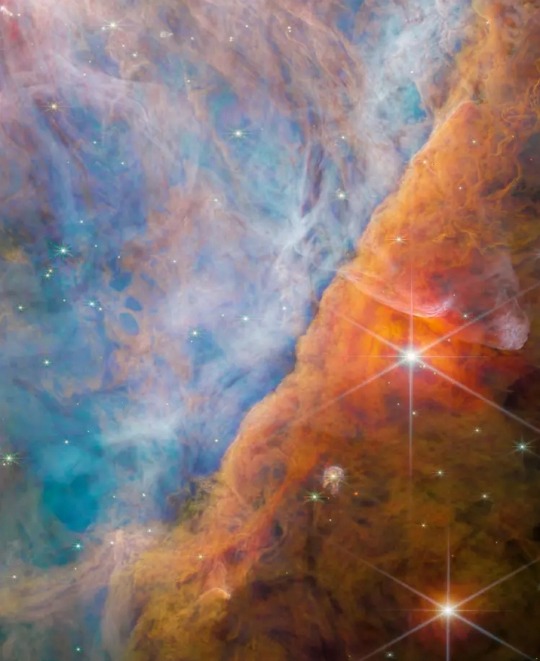
Just below Orion’s belt lies one of the most celebrated objects in the night sky: the Orion Nebula, a stellar nursery that is home to about 700 young stars.
This Webb image focuses not on the entirety of the nebula but on a structure in the lower left-hand quadrant known as the Orion Bar.
So named because of its diagonal, ridge-like appearance, the bar is shaped by the powerful radiation of the hot, young stars surrounding it.
ESA/Webb, NASA, CSA, M. Zamani (ESA/Webb), and the PDRs4All ERS Team

A baby by stellar standards, the IC 348 Star cluster is just five million years old and located about 1,000 light years from Earth.
Composed of an estimated 700 stars, IC 348 has a structure similar to wispy curtains, created by dust that reflects the light of the stars.
The conspicuous loop in the right hand side of the image is likely created by the gusting of solar winds blowing in the direction that, from Earth, would be west to east.
NASA, ESA, CSA, STScI, Kevin Luhman (PSU), Catarina Alves de Oliveira (ESA)
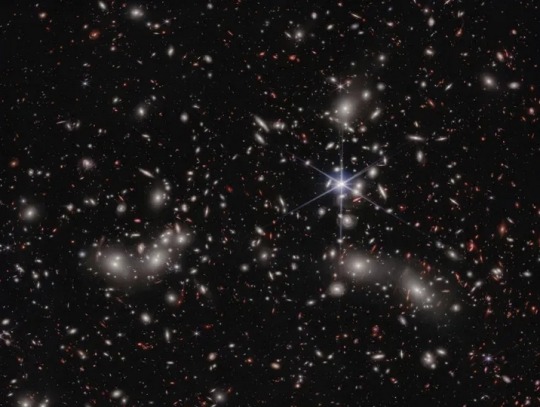
When it comes to galaxies, there's big and then there's huge and by any measure, Pandora's Cluster — more formally, known as Abell 2744 — qualifies as the latter.
Not just a galaxy, and not even a cluster of galaxies, Abell 2744 is a cluster of four clusters, which long ago collided with one another.
Located 3.5 billion light years from Earth, Pandora's Cluster measures a staggering 350 million years across.
The cluster's massive collective gravity allows astronomers to use it as a gravitational lens, bending and magnifying the light of foreground objects, making them easier to study.
NASA, ESA, CSA, I. Labbe (Swinburne University of Technology) and R. Bezanson (University of Pittsburgh). Image processing: Alyssa Pagan (STScI)

Webb was built principally to look at the oldest and most distant objects in the universe, some of 13.4 billion light years away.
But doesn't prevent the telescope from peering into its own back yard.
This image of Saturn and some of its 146 moons, rivals the images obtained by the Pioneer and Voyager probes.
NASA, ESA, CSA, STScI, Matt Tiscareno (SETI Institute), Matt Hedman (University of Idaho), Maryame El Moutamid (Cornell University), Mark Showalter (SETI Institute), Leigh Fletcher (University of Leicester), Heidi Hammel (AURA). Image processing: J. DePasquale (STScI)

Infant stars are born all over the universe, but the closest stellar birthing suite to Earth is the Rho Ophiuchi cloud complex, located just 460 light years distant.
A turbulent — even violent — place, Rho Ophiuchi is defined by jets of gas roaring from young stars.
Most of the stars in this comparatively modest nursery are more or less the size of the sun.
But one, known as S1, is far bigger — so much so that it is self-immolating, carving a great cavity around itself with its stellar wind, the storm of charged particle's all stars emit, though few with the gale-force power of S1.
NASA, ESA, CSA, STScI, Klaus Pontoppidan (STScI)
#James Webb Telescope#James Webb Space Telescope#telescope#space#stars#galaxies#universe#cosmos#astronomy#space photography#photpgraphy#NASA#galactic clusters#milky way galaxy#Orion’s belt#Orion Nebula#Orion Bar#Pandora's Cluster#Saturn#Rho Ophiuchi cloud complex#Trapezium Cluster#Wolf-Rayet#Ring Nebula#Antoine Darquier de Pellepoix#E.E Barnard#spiral galaxy#nebula
114 notes
·
View notes
Text

“Wild Oat”
Sex: Female
Race: Human
Height: 5’7”
Age (circa 99 AGW): 18
Aura Density: Low
Aura Reserves: Below Average
Aura Color: Violet
Semblance: Retrocognition
Weapon: Morgan
Jacques Gele's youngest daughter. The oldest among the four Schnee family soap opera girls at Beacon and the leader of team BGEL. She puts up a bitchy and arrogant front in order to cover up her various insecurities, such as the loneliness she feels from how most of her extended family doesn’t want anything to do with her, the sense of abandonment she feels over her parents leaving her with a family friend to actually raise her, the fact that she’s a bastard child, how she feels useless because her Semblance (Retrocognition - the ability to read people’s memories by touching them) has next-to-no practical use in combat, or how she’s the weakest member of her team in both skill and strength. Belka’s weapon is a laser rifle-naginata combo named Morgan that can use specialized, exuberantly expensive Dust cores fuel and modify the attributes of the beams it shoots (such as using an ice dust core to create freeze rays, or a lighting dust core to ionize the beam). She’s unfortunately bullied by the hands of team SLVR, especially Alaska. Belka’s name and weapon of choice are references to the Belkan Federation and the Belkan War from Ace Combat.
36 notes
·
View notes